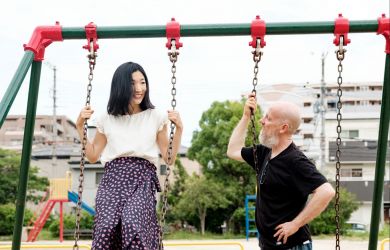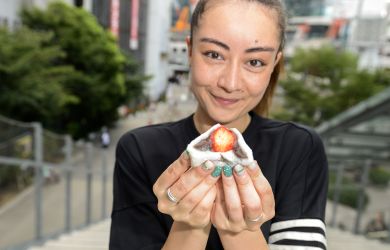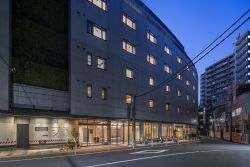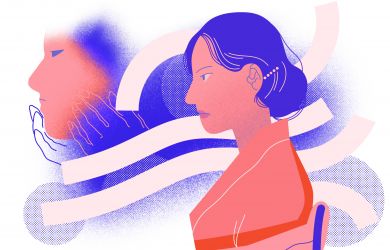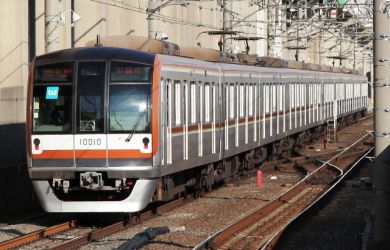
Originally published on metropolis.co.jp on February 2014

Unless your Japanese is stellar or you move in the right circles, it can be daunting to pick out a hair salon in the bright lights of this big city. With many shop fronts looking more like nightclubs and lounges than hair salons, Blade Runner-esque fashion and language and cultural barriers to navigate, many people are hesitant to head in. We sent our editor-in-chief and editorial assistant out to ask some questions—and get them styled right.

Bring a Photo
They may not be able to make you look just like Brad Pitt or Beyoncé in that photo you like, but they can certainly get an idea of the style that you are after. This is great not only for the non-Japanese speakers (showing and pointing is a great communication tool anywhere), but for anybody wanting to give an idea of what they’d like. They may not be able to do it, but they can help.
“When talking with clients,” says Kiyoko Matsuzawa of Nepenji Hair Salon in Ebisu, “it’s important to talk about the shape of their face and head. They may want a cut that doesn’t flatter their features. Any good salon will make recommendations and suggest what’s good for you.”
Don’t be shy
If a salon has caught your eye, whether by the style of cuts featured on their posters or it just looks like a place you’d go to—walk in. They may not speak English, but chances are someone there can. You can also find out their prices to compare with others.

The price
The bottom line for many people, but Tokyo comes with the stigma that everything is expensive. Sure ,in any city you can spend as much as you want, but the idea that everything in the city is overly priced is a fallacy. Matsuzawa was surprised when we mentioned this as one of our reader comments.
“Really? I think New York City is more expensive. The average cut seemed to be about $150 when I lived there. Most of the salons [like us] here in Tokyo are about ¥8,000.”
Problem Areas
Many people experience changes in the quality of their hair when they move to another country, and many factors are involved—such as changes in environment, water hardness, stress and differences in product ingredients. While it requires adjustment to your regime, Matsuzawa has some tips to make the change smoother.
“I recommend ‘no poo’ (non-use of commercial shampoos) to almost everyone, especially those with curly or wavy hair. It helps offset the chemicals we meet in daily life and doesn’t create build up or strip your hair of essential oils.”
Using a humidifier at home helps reduce damage and frizziness in winter, while in summer you’ll want to go as “clean” as possible: don’t wash your hair too often, be sure to use a good conditioner and consider using a hair treatment or getting a “head spa” once a week. As you reduce shampooing, the rate of sebum production will actually decrease, as will the need to wash your hair. It may take anywhere from two to six weeks—or even up to a year—before it adjusts completely, but it can be worth the effort, for both your health and your wallet. Note that if you use a lot of product, you should wash more often to remove this.
At the very least, says Yoshiko Morimoto of Afrodita Hair Salon in Yokohama, switch to a sulfate-free shampoo. Look for 硫酸Naフリー (ryusan Na free) or ノンシリコーン (non-silicone) on the back of the bottle.
Curly girls (and boys) should let their hair air dry if possible or use a diffuser on their hair dryer. Diffusers are sold separately in Japan and it can often be difficult to find one that fits your particular model. Here, you can again consult with your hairdresser and they can order one for you, says Matsuzawa.

Hair dyes
The amount of peroxide, as well as the shade selection, differs in Japan from many other countries. Getting your hair color “just right” is a difficult process (even back home) so be sure to let your hairdresser know the good and bad points of your last coloring experience. (It didn’t last long enough, it would be great to try a shade or two darker, etc…) Both Morimoto and Matsuzawa import dyes for use with their foreign customers.

Shampoo & conditioner
Many readers have expressed concern over Japanese shampoo not suiting their hair. Morimoto explains that the amount of moisturizer is different here compared with the West. Japanese consumers tend to want to flatten their hair, while shampoos in the U.S. and Europe tend to add more volume.
Although shipping it over yourself often seems the most practical solution, ask your hairdresser—they may be able to do it and can recommend one that suits you best. Other expats have shared that to save money (and effort), they use the above mentioned “no poo” method, but make it at home, using baking soda and apple cider vinegar, or honey. The former can be a bit pungent, so mixing in some essential oils is key. Yet others have experienced positive results with Wawaza.com’s funori seaweed cleanser, coupled with tsubaki (camellia) oil.
In General
Hairdressers with licenses issued by the Japanese government may hold a certain standard here, but may not have the experience or confidence to deal with the variety of foreigners’ hair,” says Morimoto. She also emphasizes the importance of knowing your hair, and clear communication with your stylist.
It’s better to stay away from Japanese hair extensions as they may cause a significant amount of damage to your hair.
At the Barbershop

Men. We get it. No muss, no fuss and as little collateral damage to the wallet as possible. Here’s where to go for a ¥1,000 ’do.
QB House locations are near or in train stations across the country and operate on the simple concept of 10 minutes for a single Noguchi note. www.qbhouse.co.jp
S Cut is another cut-rate chain that promises “just cuts” for ¥1,000. www.scut1000.jp
Eco’s Cut with branches in Yoyogi and Oyama, have vending machines in front where you buy a ticket for your cut. www.eco-cut.jp
Family Cut 1000 is a chain with the price right in the name. www.cut1000-job.info
Kamikiri Dokoro not only offers ¥1,000 cuts, but the Oimachi location also has an onsen, so you can relax in a hot bath after your cut. www.kamikiridokoro.co.jp/ooimachi.html
Glossary
• この写真みたいな髪型にしてください。
Kono shashin mitai na kamigata ni shite kudasai.
Please cut a similar style to this photo.
•毛先をちょっと切るだけにしてください。
Kesaki o chotto kiru dake ni shite kudasai.
Just a little off the ends, please.
• 少しだけすいてもらえますか?
Sukoshi dake suite morae masu ka?
Can you thin it out just a little bit, please?
• 七三にしてください。
Shichi-san ni shite kudasai.
Give me a 70/30, i.e. parted more to one side.
• 前髪を作ってください。
Mae-gami o tsukutte kudasai.
Please give me bangs/fringe.
• トリム torimu (trim…d’uh)
• カット katto (cut)
•レイヤード le-ya-do (layered)
• モテ髪 motegami (haircut that’ll make you popular with the opposite sex)
• 五分刈り gobugari (buzzcut, 9mm)
• 三分刈り sanbugari (buzzcut, 7mm)
• おかっぱボッブ okappa bob (Bob with bangs Think Amélie Poulain)
• 坊ちゃん刈り bocchangari (Bowl haircut—every child’s nightmare)
